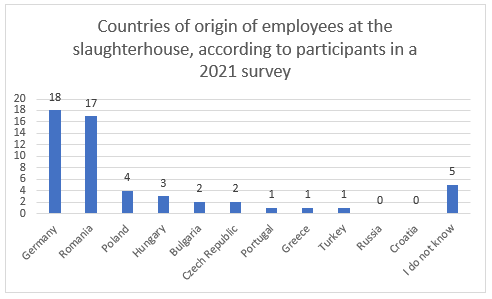The employees of slaughterhouses form a heterogeneous group of people with different levels of expertise in handling slaughter animals. In addition, there are language barriers, which can make training in animal welfare issues difficult. A study on the status quo of animal welfare training at cattle and pig abattoirs was conducted in German-speaking countries. Information were collected by means of an online survey as part of the joint research project “eSchulTS2” (BMEL funding code: 2817806A18).
From the responses, several points emerge that need to be considered when creating training programs for slaughterhouse personnel. For example, 17 respondents stated that 10-100% of the employees would not understand the German language sufficiently. This means that training organized purely in the local language would not be effective.
So far, training is mainly offered once a year completely by the slaughterhouses or in combination with external providers. The native languages of the persons to be trained are not considered in all slaughterhouses; in some cases, training is conducted entirely in German.
 Diagram created according to Isbrandt, Meemken und Langkabel (2022)
Diagram created according to Isbrandt, Meemken und Langkabel (2022)In addition to the language barrier, the content is also rated only mediocre, especially in small slaughter operations. For the training documents or the training courses, a simple and fact-based presentation of the training topics is desired. The clarity should be increased by good photo and video materials. In addition, there should be appropriate training for the different types of anesthesia.
It crystallizes that there is a desire for standardized training materials. A large part of the respondents could imagine that a Germany-wide standardized, up-to-date and non-commercial online training would have advantages over the respective currently used own animal welfare training concept. However, an almost equal proportion of respondents suggested that implementation as a purely online format might be difficult for all individuals and work areas.
In summary, for the design of animal welfare training at slaughterhouses, there is a desire for multilingual animal welfare training that is standardized throughout Germany and that would be desirable to be conducted in presence.
Impact:
- Animal health and welfare: Better trained staff means a big plus for animal welfare, especially in the stressful situation before and during slaughter.
- Production efficiency and meat quality: Better trained personnel mean faster work in some cases, thus reducing the working time per animal. Carcass quality will also benefit from better trained personnel.
Examples for training in slaughter:
- Eyes on Animals offers animal handling training: https://www.eyesonanimals.com/de/schulungsanfrage/ and also offers a guide to raising animal welfare standards and meat quality in slaughterhouses on its website. This contains many pictures and is in English: https://www.eyesonanimals.com/wp-content/uploads/2016/04/2015-06-18-Slaughterhouse-Modernization-Manual-EN-web-version.pdf
- The Better Training for Safer Food (BTSF) Academy also offers courses in this area. For example, the website has e-learning modules on Animal Welfare at slaughter and killing for disease control, among other topics. The course is available in English. https://btsfacademy.eu/training/course/index.php?categoryid=45
Source:
- Isbrandt, R.; Meemken, D.; Langkabel, N. (2022):Tierschutzschulungen an Rinder- und Schweineschlachtbetrieben: Ergebnisse einer Online-Umfrage aus dem deutschsprachigen Raum. Berliner und Münchener tierärztliche Wochenschrift; 135(4), S. 1–16. www.vetline.de/tierschutzschulungen-an-rinder-und-schweineschlachtbetrieben-ergebnisse-einer-online-umfrage-ausDetails